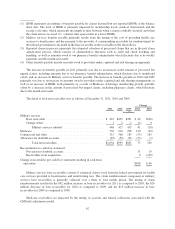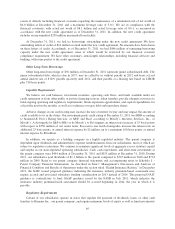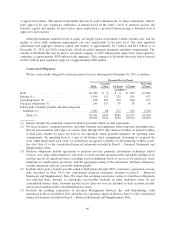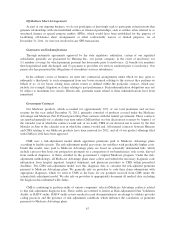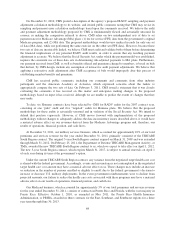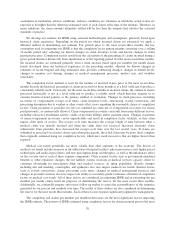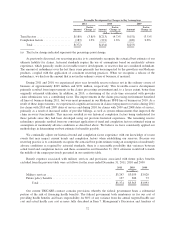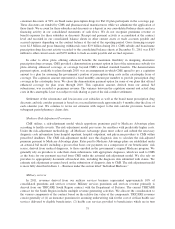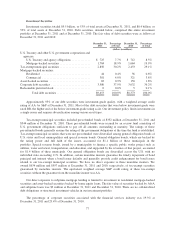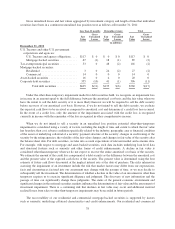Humana 2011 Annual Report Download - page 79
Download and view the complete annual report
Please find page 79 of the 2011 Humana annual report below. You can navigate through the pages in the report by either clicking on the pages listed below, or by using the keyword search tool below to find specific information within the annual report.
The loss of any of the contracts above or significant changes in these programs as a result of legislative
action, including reductions in premium payments to us, or increases in member benefits without corresponding
increases in premium payments to us, may have a material adverse effect on our results of operations, financial
position, and cash flows.
Critical Accounting Policies and Estimates
The discussion and analysis of our financial condition and results of operations is based upon our
consolidated financial statements and accompanying notes, which have been prepared in accordance with
accounting principles generally accepted in the United States of America. The preparation of these financial
statements and accompanying notes requires us to make estimates and assumptions that affect the amounts
reported in the consolidated financial statements and accompanying notes. We continuously evaluate our
estimates and those critical accounting policies related primarily to benefit expenses and revenue recognition as
well as accounting for impairments related to our investment securities, goodwill, and long-lived assets. These
estimates are based on knowledge of current events and anticipated future events and, accordingly, actual results
ultimately may differ from those estimates. We believe the following critical accounting policies involve the
most significant judgments and estimates used in the preparation of our consolidated financial statements.
Benefit Expense Recognition
Benefit expenses are recognized in the period in which services are provided and include an estimate of the
cost of services which have been incurred but not yet reported, or IBNR. IBNR represents a substantial portion of
our benefits payable as follows:
December 31, Percentage December 31, Percentage
2011 of Total 2010 of Total
(dollars in millions)
IBNR .......................................... $2,056 54.8% $2,051 59.1%
Reported claims in process ......................... 376 10.0% 137 3.9%
Other benefits payable ............................. 983 26.2% 1,026 29.6%
Benefits payable, excluding military services ....... 3,415 91.0% 3,214 92.6%
Military services benefits payable .................... 339 9.0% 255 7.4%
Total benefits payable ......................... $3,754 100.0% $3,469 100.0%
Military services benefits payable primarily consists of our estimate of incurred healthcare services provided
to beneficiaries which are in turn reimbursed by the federal government as more fully described in Note 2 to the
consolidated financial statements included in Item 8. – Financial Statements and Supplementary Data. This
amount is generally offset by a corresponding receivable due from the federal government, as more fully-
described in Item 7. Management’s Discussion and Analysis of Financial Condition and Results of Operations
under the section titled “Cash Flow from Operating Activities.”
Estimating IBNR is complex and involves a significant amount of judgment. Changes in this estimate can
materially affect, either favorably or unfavorably, our results of operations and overall financial position.
Accordingly, it represents a critical accounting estimate. Most benefit claims are paid within a few months of the
member receiving service from a physician or other health care provider. As a result, these liabilities generally
are described as having a “short-tail”. As such, we expect that substantially all of the December 31, 2011
estimate of benefits payable will be known and paid during 2012.
Our reserving practice is to consistently recognize the actuarial best point estimate within a level of
confidence required by actuarial standards. Actuarial standards of practice generally require a level of confidence
such that the liabilities established for IBNR have a greater probability of being adequate versus being
insufficient, or such that the liabilities established for IBNR are sufficient to cover obligations under an
69





